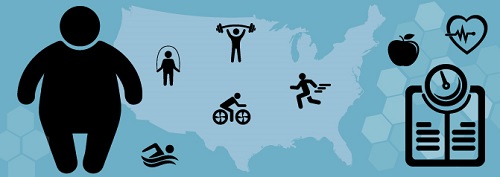
The Problem:
The State of Obesity: Better Policies for a Healthier America breaks down the numbers across the country, based on statistics from the Centers for Disease Control and Prevention. Latinos and African-Americans are disproportionately affected.
- 42 percent of Latino and 47.8 percent of African-American adults are obese compared with 32.6 percent of whites. More than 77 percent of Latino and 75 percent of African-American adults are overweight or obese, compared with 67.2 percent of whites.
- 22.4 percent of Latino children ages 2 to 19 are obese, compared with 14.3 percent of white children. More than 38.9 percent of Latino children are overweight or obese, compared with 28.5 percent of white children.
- Rates of severe obesity (BMI above 40, greater than 120 percent of the weight and height percentiles for an age range) are also higher among Latino children ages 2 to 19 (6.6 percent) and in African American children (8 percent) compared with White children (3.9 percent).
Why the statistics matter:
Being overweight or obese can carry serious health risks. Here are some examples how the obesity rates play out in terms of health.
- The 10 states with the highest rates of hypertension are all in the South. West Virginia had the highest rate.
- Approximately 20 percent of cancer in women and 15 percent of cancer in men is attributable to obesity.
- An estimated 24.2 percent of kidney disease cases among men and 33.9 percent of cases among women are related to overweight and obesity.
- Almost 70 percent of individuals diagnosed with arthritis are overweight or obese.
- Both overweight and obesity at midlife independently increase the risk of dementia, Alzheimer’s disease and vascular dementia.
- A study by the Urban Institute found rate differences among Latinos, African-Americans and whites for diabetes, heart disease, high blood pressure, renal disease and stroke — many of which are often related to obesity — cost the healthcare system $23.9 billion annually. Based on current trends, by 2050, this is expected to double to $50 billion a year.
The Solutions.
The State of Obesity report suggests strategies to address these disparities, including targeting the challenges that stem from neighborhoods, schools, workplaces and marketing practices that make it difficult to access healthy affordable foods and be physically active. Here are a few ideas.
- Ensure community-based obesity prevention and control strategies are culturally and linguistically appropriate
- Increase the use of promotores (community health workers, peer leaders and health advocates) who more effectively connect Latino communities with public health services.
- Standards to limit the amount of advertising of foods of low nutritional value, especially those targeting Latino and African-American children through television, radio and digital media.
- Recruitment of grocery stores through grant programs or other efforts to support affordable healthy products.
- Partnerships between government, businesses, faith-based groups, community organizations, schools and others to create healthy food access and safe places for physical activity in neighborhoods.
- Investments in community prevention should directly involve local communities.